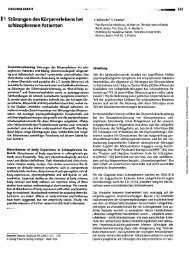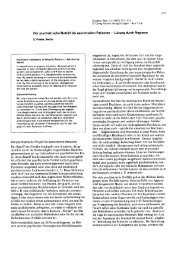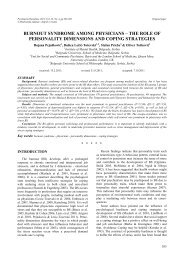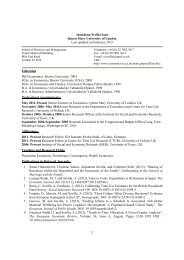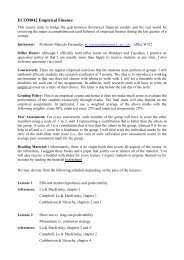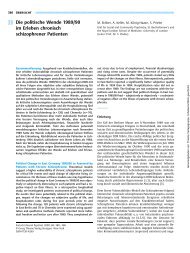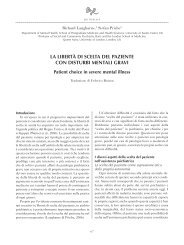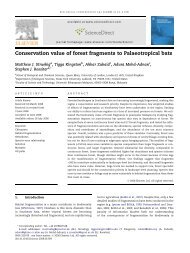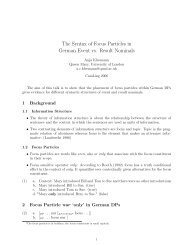Proofs - Personal Webspace for QMUL - Queen Mary, University of ...
Proofs - Personal Webspace for QMUL - Queen Mary, University of ...
Proofs - Personal Webspace for QMUL - Queen Mary, University of ...
You also want an ePaper? Increase the reach of your titles
YUMPU automatically turns print PDFs into web optimized ePapers that Google loves.
S68 S. Penka et al. / European Psychiatry 27 (2012) / supplement n°2 / S63-S69<br />
Item Subpoints<br />
1. Institution 1.1. General in<strong>for</strong>mation about institution (function, pr<strong>of</strong>ession <strong>of</strong> interviewee etc.)<br />
1.2 Policy <strong>of</strong> institution (existing policy)<br />
2. Staff 2.1. Number <strong>of</strong> staff in previous year (divided by salaried employees, freelancers, trainees etc.)<br />
2.2 In<strong>for</strong>mation about staff with migration background (divided by salaried employees, freelancers, etc;<br />
country <strong>of</strong> origin)<br />
2.3 J ob advertisements (in the last four years, migrants encouraged to apply, fi lled by migrant)<br />
2.4 Occupational categories (number <strong>of</strong> staff per occupation, number <strong>of</strong> migrants per pr<strong>of</strong>ession,<br />
number <strong>of</strong> employees without German citizenship)<br />
3. Clients/ Patients general 3.1 Number <strong>of</strong> clients/ patients (number previous year, data base)<br />
4. Clients/ Patients with 4.1 Utilisation by migrants (subjective assessment <strong>of</strong> claims made by migrants, reasons)<br />
migration background 4.2 In<strong>for</strong>mation about migration background (recording data relation to migration background, etc.)<br />
4.3 Number <strong>of</strong> clients/ patients with migration background in previous year (number, data base)<br />
5. Access 5.1 Access routes to institution (number <strong>of</strong> clients/ patients per each route, predominant routes by<br />
migrants<br />
6. Aftercare 6.1 Aftercare (specialized aftercare protocols, inclusion <strong>of</strong> contacts with intercultural or migrant- specifi c<br />
facilities, description)<br />
7. Migrant- specifi c <strong>of</strong>fers 7.1 Migrant specifi c <strong>of</strong>fers (existing migrant specifi c <strong>of</strong>fers, description, reasons <strong>for</strong> (non- ) existing)<br />
8. Facilities and services 8.1 Offer <strong>of</strong> facilities and services (Non- German newspapers in public areas; multilingual door plates,<br />
inscriptions etc. in and outside <strong>of</strong> institution; rooms <strong>for</strong> religious practices; provision <strong>of</strong> suitable food<br />
according to religion etc.)<br />
9. Linguistic communication 9.1 Language skills <strong>of</strong> staff (number and names <strong>of</strong> <strong>for</strong>eign languages and mother tongue <strong>of</strong> staff divided<br />
by occupation)<br />
9.2 Linguistic communication with Non- German speaking clients/ patients (percentage <strong>of</strong> clients /<br />
patients care / treatment in German language not being possible; frequency <strong>of</strong> communication<br />
with the help <strong>of</strong> use <strong>of</strong> gestures, persons accompanying client/ patient, use <strong>of</strong> native- speaking<br />
employees, use <strong>of</strong> pr<strong>of</strong>essional interpreter etc.)<br />
9.3 Interpreters (work with interpreters, frequency <strong>of</strong> involvement, fi nancing <strong>of</strong> interpreters,<br />
Reasons <strong>for</strong> non- involvement <strong>of</strong> interpreters etc.)<br />
9.4 Cultural mediation (Provision <strong>of</strong> cultural mediation, description)<br />
10. Continuing intercultural 10.1 Continuing education on intercultural subjects, intercultural competence and intercultural<br />
education, cultural<br />
team work (participation <strong>of</strong> employees in continuing education on these topics, encouragement<br />
competence and team- work by management to participate, employees regularly asked to participate etc.)<br />
10.2 Intercultural competence (understanding <strong>of</strong> intercultural competence <strong>of</strong> interviewee, intercultural<br />
competence <strong>of</strong> staff etc.)<br />
10.3 Intercultural team work (employees with migration background in charge <strong>of</strong> clients/ patients with<br />
migration background, existing tandem- .counseling etc.)<br />
10.4 Case discussion (consideration <strong>of</strong> cultural and migration- specifi c aspects, frequency <strong>of</strong> taking into<br />
consideration, occupational groups taking part etc.)<br />
10.5 Supervision (employees receiving supervision; frequency; occupational groups participating,<br />
consideration <strong>of</strong> subjects interaction with migrants etc.)<br />
11. Survey <strong>of</strong> demand, demand 11.1 Quality control (employed measures, consideration <strong>of</strong> persons with migration<br />
planning<br />
background or migrant- specifi c topics, how)<br />
12. In<strong>for</strong>mation 12.1 In<strong>for</strong>mation material and in<strong>for</strong>mation paths (in<strong>for</strong>mation leafl ets in various languages, client- /<br />
patient- in<strong>for</strong>mation in various languages, multilingual website, outreach activities in migrant<br />
community structures etc.)<br />
13. Empowerment/<br />
13.1 Contact person <strong>for</strong> migrants (existing contact point/ contact person <strong>for</strong> patients / clients in general,<br />
Participation<br />
support <strong>of</strong> specifi c migrant- issues etc.)<br />
<strong>of</strong> migrants<br />
13.2 Self- help groups (support <strong>of</strong> patients/ clients in fi nding or founding self- help group, support <strong>of</strong><br />
migrants etc.)<br />
14. Cooperation 14.1 Cooperation with institutions (existing cooperation, with whom)<br />
15. Intercultural opening 15.1 Management Level (support/ promotion <strong>of</strong> intercultural opening by management, management<br />
interested in improving care/ treatment <strong>of</strong> migrants, person with migration background employed at<br />
management level etc.)<br />
16. Goals reached 16.1 Services utilized by persons with migration background to equal degree as other clients/ patients<br />
17. Outlook 17.1 Estimation with regard to equal access to psychosocial care compared to indigenous Germans<br />
17.2 Kind <strong>of</strong> interaction generally liken to see in psycho- social care<br />
Fig. 3. The fi nal assessment tool.<br />
<strong>Pro<strong>of</strong>s</strong>




